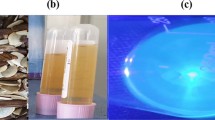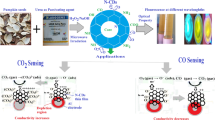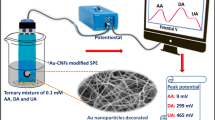Abstract
Copper-doped carbon dots and aminated carbon nanotubes (Cu-CDs/NH2-CNTs) nanocomposites were synthesized by a one-step growth method, and the composites were characterized for their performance. An electrochemical sensor for sensitive detection of bisphenol A (BPA) was developed for using Cu-CDs/NH2-CNTs nanocomposites modified with glassy carbon electrodes (GCE). The sensor exhibited an excellent electrochemical response to BPA in 0.2 M PBS (pH 7.0) under optimally selected conditions. The linear range of the sensor for BPA detection was 0.5–160 μM, and the detection limit (S/N = 3) was 0.13 μM. Moreover, the sensor has good interference immunity, stability and reproducibility. In addition, the feasibility of the practical application of the sensor was demonstrated by the detection of BPA in bottled drinking water and Liu Yang River water.
Graphical abstract







Similar content being viewed by others
Data availability
The authors confirm that the data supporting the findings of this study are available within the article and its supplementary materials.
References
Conti L, Mummolo L, Romano GM, Giorgi C, Giacomazzo GE, Prodi L, Bencini A (2021) Exploring the ability of luminescent metal assemblies to bind and sense anionic or ionizable analytes a Ru(phen)2bipy-based dizinc complex for BPA (BPA) recognition. Molecules 26(3):527
Facina CH, Campos SGP, Ruiz TFR, Goes RM, Vilamaior PSL, Taboga SR (2021) Protective effect of the association of curcumin with piperine on prostatic lesions: new perspectives on BPA-induced carcinogenesis. Food Chem Toxicol 158:112700
Gan L, Wang L, Xu L, Fang X, Pei C, Wu Y, Lu H, Han S, Cui J, Shi J, Mei C (2021) Fe3C-porous carbon derived from Fe2O3 loaded MOF-74(Zn) for the removal of high concentration BPA: the integrations of adsorptive/catalytic synergies and radical/non-radical mechanisms. J Hazard Mater 413:125305
Liang S, Ziyu Z, Fulong W, Maojuan B, ** CuO for BPA removal. Environ Res 205:112529
Lim DS, Kwack SJ, Kim KB, Kim HS, Lee BM (2009) Potential risk of BPA migration from polycarbonate containers after heating, boiling, and microwaving. J Toxicol Environ Health A 72:1285–1291
Ahmed Zaki MS, Haidara MA, Abdallaa AM, Mohammed H, Sideeg AM, Eid RA (2021) Role of dietary selenium in alleviating BPA toxicity of liver albino rats: Histological, ultrastructural, and biomarker assessments. J Food Biochem 45:e13725
Alam AU, Qin Y, Catalano M, Wang L, Kim MJ, Howlader MMR, Hu NX, Deen MJ (2018) Tailoring MWCNTs and beta-Cyclodextrin for sensitive detection of acetaminophen and estrogen. ACS Appl Mater Interfaces 10:21411–21427
Alabi OA, Ologbonjaye KI, Sorungbe AA, Shokunbi OS, Omotunwase OI, Lawanson G, Ayodele OG (2021) BPA-induced alterations in different stages of spermatogenesis and systemic toxicity in Albino mice (Mus musculus). J Health Pollut 11:210307
Bi N, Ding J, Zou R, Gu X, Liu ZH, Wang HL (2021) Developmental exposure of BPA induces spatial memory deficits by weakening the excitatory neural circuits of CA3-CA1 and EC-CA1 in mice. Toxicol Appl Pharmacol 426:115641
Brulport A, Lencina C, Chagnon MC, Le Corre L, Guzylack-Piriou L (2021) Transgenerational effects on intestinal inflammation status in mice perinatally exposed to bisphenol S. Chemosphere 262:128009
Pellerin È, Chabaud S, Pouliot F, Pelletier M, Bolduc S (2021) Bisphenol A Alters the energy metabolism of stromal cells and could promote bladder cancer progression. Cancers 13:5461
Fan H, Fernando SR, Jiang L, Wang Z, Kodithuwakku SP, Wong CKC, Ng EHY, Yeung WSB, Lee KF (2021) BPA Analogues suppress spheroid attachment on human endometrial epithelial cells through modulation of steroid hormone receptors signaling pathway. Cells 10:2882
Farahbakhsh F, Heydari-Bafrooei E, Ahmadi M, HodaHekmatara S, Sabet M (2021) A novel aptasensing method for detecting BPA using the catalytic effect of the Fe3O4/Au nanoparticles on the reduction reaction of the silver ions. Food Chem 355:129666
Hassan NH, Othman H, Abdul Malek NR, Zulkurnain M, Saad B, Wong YF (2020) Simultaneous quantitative assessment of ochratoxin A, patulin, 5-hydroxymethylfurfural, and BPA in fruit drinks using HPLC with diode array-fluorimetric detection. Foods 9:1633
Ousji O, Sleno L (2021) In vitro metabolism of five BPA analogs studied by LC-HRMS/MS. J Am Soc Mass Spectrom 32:847–859
Dhivya R, Kavitha V, Viswanathamurthi P (2020) A bisphenol based fluorescence chemosensor for the selective detection of Zn(2+) and PPi ions and its bioluminescence imaging. Spectrochim Acta A Mol Biomol Spectrosc 242:118730
Alam AU, Deen MJ (2020) BPA Electrochemical sensor using graphene oxide and beta-cyclodextrin-functionalized multi-walled carbon nanotubes. Anal Chem 92:5532–5539
Richardson SD, Kimura SY (2020) Water analysis: emerging contaminants and current issues. Anal Chem 92:473–505
Hersey M, Berger SN, Holmes J, West A, Hashemi P (2019) Recent developments in carbon sensors for at-source electroanalysis. Anal Chem 91:27–43
Jemmeli D, Marcoccio E, Moscone D, Dridi C, Arduini F (2020) Highly sensitive paper-based electrochemical sensor for reagent free detection of BPA. Talanta 216:120924
Wang X, Luo D, Wang J, Sun Z, Cui G, Chen Y, Wang T, Zheng L, Zhao Y, Shui L, Zhou G, Kempa K, Zhang Y, Chen Z (2021) Strain engineering of a MXene/CNT hierarchical porous hollow microsphere electrocatalyst for a high-efficiency lithium polysulfide conversion process. Angew Chem Int Ed Engl 60:2371–2378
Zhi L, Gorelik T, Friedlein R, Wu J, Kolb U, Salaneck WR, Mullen K (2005) Solid-state pyrolyses of metal phthalocyanines: a simple approach towards nitrogen-doped CNTs and metal/carbon nanocables. Small 1:798–801
Zhang H, Ono LK, Tong G, Liu Y, Qi Y (2021) Long-life lithium-sulfur batteries with high areal capacity based on coaxial CNTs@TiN-TiO2 sponge. Nat Commun 12:4738
Xu J, Wen Q, Zhang X, Li Y, Cui Z, Li P, Pan C (2021) One-step construction of multi-walled CNTs loaded with Alpha-Fe2O3 nanoparticles for efficient photocatalytic properties. Materials (Basel) 14:2820
Lu Q, Su T, Shang Z, ** D, Shu Y, Xu Q, Hu X (2021) Flexible paper-based Ni-MOF composite/AuNPs/CNTs film electrode for HIV DNA detection. Biosens Bioelectron 184:113229
Liu W, Wu L, Zhang X, Chen J (2014) Highly-selective electrochemical determination of catechol based on 3-aminophenylboronic acid-3,4,9,10-perylene tetracarboxylic acid functionalized carbon nanotubes modified electrode. Anal Methods 6:718–724
Xu X, Li X, Miao J, Liu L, Huang X, Wei Q, Cao W (2021) A dual-mode label-free electrochemical immunosensor for ultrasensitive detection of procalcitonin based on g-C3N4-NiCo2S4-CNTs-Ag NPs. Analyst 146:3169–3176
Aftab S, Kurbanoglu S, Ozcelikay G, Bakirhan NK, Shah A, Ozkan SA (2019) Carbon quantum dots co-catalyzed with multiwalled carbon nanotubes and silver nanoparticles modified nanosensor for the electrochemical assay of anti-HIV drug Rilpivirine. Sens Actuators, B Chem 285:571–583
Guo J, Lu W, Zhang H, Meng Y, Du F, Shuang S, Dong C (2021) Copper doped carbon dots as the multi-functional fluorescent sensing platform for tetracyclines and ph. Sens Actuators, B Chem 330:129360
Gunanathan C, Milstein D (2013) ChemInform abstract: applications of acceptorless dehydrogenation and related transformations in chemical synthesis. ChemInform 44:2931–2953
Ethordevic L, Arcudi F, Prato M (2019) Preparation, functionalization and characterization of engineered carbon nanodots. Nat Protoc 14:2931–2953
Wang Y, Liu X, Liu J, Han B, Hu X, Yang F, Xu Z, Li Y, Jia S, Li Z, Zhao Y (2018) Carbon quantum dot implanted graphite carbon nitride nanotubes: excellent charge separation and enhanced photocatalytic hydrogen evolution. Angew Chem Int Ed Engl 57:5765–5771
Brege JJ, Hamilton CE, Crouse CA, Barron AR (2009) Ultrasmall copper nanoparticles from a hydrophobically immobilized surfactant template. Nano Lett 9:2239–2242
Wu W, Zhan L, Fan W, Song J, Li X, Li Z, Wang R, Zhang J, Zheng J, Wu M, Zeng H (2015) Cu-N dopants boost electron transfer and photooxidation reactions of carbon dots. Angew Chem Int Ed Engl 54:6540–6544
Li M, Wang M, Zhu L, Li Y, Yan Z, Shen Z, Cao X (2018) Facile microwave assisted synthesis of N-rich carbon quantum dots/dual-phase TiO2 heterostructured nanocomposites with high activity in CO2 photoreduction. Appl Catal B 231:269–276
Koyun O, Gorduk S, Gencten M, Sahin Y (2019) A novel copper(ıı) phthalocyanine-modified multiwalled carbon nanotube-based electrode for sensitive electrochemical detection of BPA. New J Chem 43:85–92
Pei DN, Zhang AY, Pan XQ, Si Y, Yu HQ (2018) Electrochemical sensing of BPA on facet-tailored TiO2 single crystals engineered by inorganic-framework molecular imprinting sites. Anal Chem 90:3165–3173
Ye Z, Wang Q, Qiao J, Ye B, Li G (2019) Simultaneous detection of BPA and bisphenol S with high sensitivity based on a new electrochemical sensor. J Electroanal Chem 854:113541
Pang Y-H, Huang Y-Y, Wang L, Shen X-F, Wang Y-Y (2020) Determination of BPA and bisphenol S by a covalent organic framework electrochemical sensor. Environ Pollut 263:114616
Hu X, Feng Y, Wang H, Zhao F, Zeng B (2018) A novel BPA electrochemical sensor based on a molecularly imprinted polymer/carbon nanotubes-Au nanoparticles/boron-doped ordered mesoporous carbon composite. Anal Methods 10:4543–4548
Funding
This work was financially supported by the Major Projects of Scientific Research in Higher Educational Institutions in Anhui Province, China (2023AH040201), the Natural Science Foundation of Hunan Province, China (2020JJ4035), the Foundation of Hunan Provincial Key Laboratory of Crop Germplasm Innovation and Resource Utilization (18KFXM07), the Key Projects of Scientific Research in Higher Educational Institutions in Anhui Province (2022AH052058), and Department of Science and Technology of Yunnan Province (202201AU070213 and 202101AZ070001-118).
Author information
Authors and Affiliations
Corresponding authors
Ethics declarations
Conflict of interest
The authors declare that there is no conflict of interests regarding the publication of this article.
Additional information
Publisher's Note
Springer Nature remains neutral with regard to jurisdictional claims in published maps and institutional affiliations.
Supplementary Information
Below is the link to the electronic supplementary material.
Rights and permissions
Springer Nature or its licensor (e.g. a society or other partner) holds exclusive rights to this article under a publishing agreement with the author(s) or other rightsholder(s); author self-archiving of the accepted manuscript version of this article is solely governed by the terms of such publishing agreement and applicable law.
About this article
Cite this article
Liu, W., Li, M., Zhang, P. et al. One-step growth of Cu-doped carbon dots in amino-modified carbon nanotube–modified electrodes for sensitive electrochemical detection of BPA. Microchim Acta 191, 309 (2024). https://doi.org/10.1007/s00604-024-06344-x
Received:
Accepted:
Published:
DOI: https://doi.org/10.1007/s00604-024-06344-x




